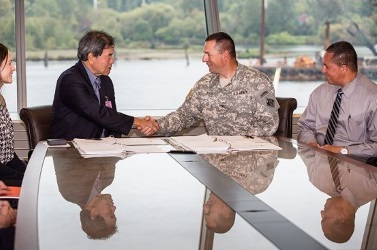
| September 30, 2014 | |
Agreements: Houston, Seattle
![]() Print this Article | Send to Colleague
Print this Article | Send to Colleague
A cooperation agreement between the Port of Houston and the Port of Antwerp was signed on September 29 in conjunction with the kickoff of the 2014 Breakbulk Americas Conference. The U.S. Army Corps of Engineers and Port of Seattle signed an agreement on September 29 moving forward with a $3 million cost-shared feasibility study to investigate potential port deepening alternatives.
A cooperation agreement between the Port of Houston and the Port of Antwerp was signed on September 29 in conjunction with the kickoff of the 2014 Breakbulk Americas Conference.
While the Port of Houston is the largest break bulk port in the United States, Antwerp operates the largest break bulk terminal in Europe. Under the agreement, the ports will exchange information ranging from customs to business development and each will commit to hosting a commercial event in alternating years.
The Port of Houston Authority is the host for the Breakbulk Americas conference, which is being held at the George R. Brown Convention Center in downtown Houston. The conference is the largest gathering of break bulk executives in the United States. In 2012, the last time it was held in Houston, the conference welcomed a total of 4,245 attendees.
The Port of Houston Authority has recorded near-record levels of steel moving across its docks this year. Steel stands at 4.3 million tons in year-to-date results – a gain of 39 percent over the same period last year. Further, the port recently acquired a new crane at the Turning Basin Terminal that can handle up to 800 tons. In place at Dock 32, the crane comes from Barnhart, which specializes in heavy lifting and transport. Barnhart will permanently deploy the crane at the dock, and it will occupy its own three-acre pad in the 32A yard. This crane will be available to rent for heavy-lifts.
Corps of Engineers, Port of Seattle Sign Harbor Deepening Cost-Sharing Agreement
The U.S. Army Corps of Engineers and Port of Seattle signed an agreement on September 29 moving forward with a $3 million cost-shared feasibility study to investigate potential port deepening alternatives.

L to R: Linda Styrk, Port of Seattle Managing Seaport Director; Tay Yoshitani, Port of Seattle CEO; Colonel John Buck, USACE; Olton Swanson, Deputy District Engineer for Programs & Project Management and Chief, Programs & Project Management Division.
Photo/Port of Seattle
In March 2012, the Corps’ preliminary report found there is federal interest in potentially deepening Seattle Harbor’s East and West Waterways and this feasibility study will determine if there is an economically-justifiable alternative. Seattle District Commander Col. John Buck and Port of Seattle Chief Executive Officer Tay Yoshitani signed the agreement.
"The Port of Seattle greatly appreciates the Corps of Engineers in starting this study," said Yoshitani. "This is another step in keeping the Pacific Northwest a competitive trade gateway, and keeping thousands of local jobs here."
The president included the feasibility study in the administration’s Fiscal Year 2014 budget and Congress gave the green light to pursue it in their annual fiscal year spending bill. It is the second of several studies the Corps is required to complete in its process. The process provides multiple opportunities for public outreach and input.
Authorized waterway depths are currently between -34 and -51 feet mean lower low water (MLLW). The study will investigate to depths of -55 feet MLLW, taking into consideration economics, cost, risk, environmental aspects, cultural resources, fish habitat, endangered species, geotechnical, coastal engineering and cost engineering.
The Corps and port will split the cost equally and the study should be complete in three years. When complete, the feasibility report will include a net benefit analysis and the required National Environmental Policy Act documentation will disclose any environmental effects of deepening the existing channel.
